Related Research Articles
Æthelberht was King of Kent from about 589 until his death. The eighth-century monk Bede, in his Ecclesiastical History of the English People, lists him as the third king to hold imperium over other Anglo-Saxon kingdoms. In the late ninth century Anglo-Saxon Chronicle, he is referred to as a bretwalda, or "Britain-ruler". He was the first English king to convert to Christianity.

Gregory the Illuminator was the founder and first official head of the Armenian Apostolic Church. He converted Armenia from Zoroastrianism to Christianity in the early fourth century, making Armenia the first state to adopt Christianity as its official religion. He is venerated as a saint in the Armenian Apostolic Church and in some other churches.
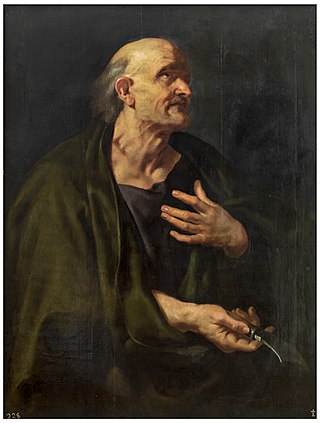
Bartholomew was one of the twelve apostles of Jesus according to the New Testament. Most scholars today identify Bartholomew as Nathanael or Nathaniel, who appears in the Gospel of John.

Abgar V, called Ukkāmā, was the King of Osroene with his capital at Edessa.

The Armenian Apostolic Church is the national church of the Armenian people. Part of Oriental Orthodoxy, it is one of the most ancient Christian institutions. The Kingdom of Armenia was the first state to adopt Christianity as its official religion under the rule of King Tiridates III, of the Arsacid dynasty in the early 4th century. According to tradition, the church originated in the missions of Apostles Bartholomew and Thaddeus of Edessa in the 1st century. St. Gregory the Illuminator was the first official primate of the church. It is sometimes referred to as the Armenian Apostolic Orthodox Church, Armenian Church or Armenian Gregorian Church.

Jude was one of the Twelve Apostles of Jesus according to the New Testament. He is generally identified as Thaddeus, and is also variously called Judas Thaddaeus, Jude Thaddaeus, Jude of James, or Lebbaeus and is considered as the founding father and the first Catholicos-Patriarch of the Armenian Apostolic Church. He is sometimes identified with Jude, the brother of Jesus, but is clearly distinguished from Judas Iscariot, the apostle who betrayed Jesus prior to his crucifixion. Catholic writer Michal Hunt suggests that Judas Thaddaeus became known as Jude after early translators of the New Testament from Greek into English sought to distinguish him from Judas Iscariot and subsequently abbreviated his forename. Most versions of the New Testament in languages other than English and French refer to Judas and Jude by the same name.
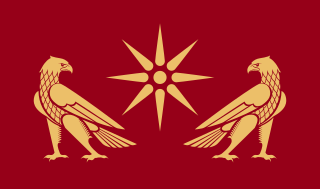
Armenia, also the Kingdom of Greater Armenia, or simply Greater Armenia sometimes referred to as the Armenian Empire, was a kingdom in the Ancient Near East which existed from 331 BC to 428 AD. Its history is divided into the successive reigns of three royal dynasties: Orontid, Artaxiad and Arsacid (52–428).
Saint NinoEqual to the Apostles and the Enlightener of Georgia was a woman who preached Christianity in the territory of Caucasian Iberia, of what is now part of Georgia. It resulted in the Christianization of the royal house of Iberia, with the consequent Christianization of Iberia.

"The Second Nun's Tale", written in late Middle English, is part of Geoffrey Chaucer's The Canterbury Tales. Narrated by a nun who remains unnamed, it is a hagiography of the life of Saint Cecilia.
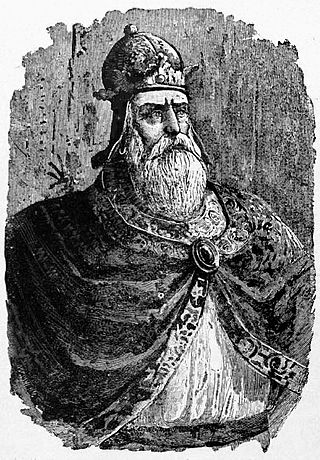
Tiridates III, also known as Tiridates the Great, or Tiridates IV, was the Armenian Arsacid king from c.298 to c. 330.
According to Eastern Christian tradition, Addai of Edessa or Thaddeus of Edessa was one of the seventy disciples of Jesus. He is possibly identical with Thaddaeus, one of the Twelve Apostles. From an early date his hagiography is filled with legends and fabrications. The saint himself may be entirely fictitious.

The Monastery of Saint Thaddeus is an ancient Armenian monastery in the mountainous area of West Azerbaijan Province, Iran. It is believed to be one of the oldest church buildings in the world.

Eastern Christian monasticism is the life followed by monks and nuns of the Eastern Orthodox Church, Oriental Orthodoxy, the Church of the East and Eastern Catholicism. Eastern monasticism is founded on the Rule of St Basil and is sometimes thus referred to as Basilian.

Saint Ephigenia of Ethiopia or Iphigenia of Ethiopia, also called Iphigenia of Abyssinia, is a folk saint whose life is told in the Golden Legend as a virgin converted to Christianity and then consecrated to God by St. Matthew the Apostle, who was spreading the Gospel to the region of "Ethiopia," which in this case is understood to be located in the regions south of the Caspian Sea, either in one of the provinces of Mesopotamia, or in Ancient Armenia (Colchis).
Kyneburga, Kyneswide and Tibba were female members of the Mercian royal family in 7th century England who were venerated as saints.
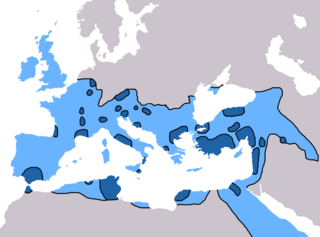
In the 5th century in Christianity, there were many developments which led to further fracturing of the State church of the Roman Empire. Emperor Theodosius II called two synods in Ephesus, one in 431 and one in 449, that addressed the teachings of Patriarch of Constantinople Nestorius and similar teachings. Nestorius had taught that Christ's divine and human nature were distinct persons, and hence Mary was the mother of Christ but not the mother of God. The Council rejected Nestorius' view causing many churches, centered on the School of Edessa, to a Nestorian break with the imperial church. Persecuted within the Roman Empire, many Nestorians fled to Persia and joined the Sassanid Church thereby making it a center of Nestorianism. By the end of the 5th century, the global Christian population was estimated at 10-11 million. In 451 the Council of Chalcedon was held to clarify the issue further. The council ultimately stated that Christ's divine and human nature were separate but both part of a single entity, a viewpoint rejected by many churches who called themselves miaphysites. The resulting schism created a communion of churches, including the Armenian, Syrian, and Egyptian churches, that is today known as Oriental Orthodoxy. In spite of these schisms, however, the imperial church still came to represent the majority of Christians within the Roman Empire.

Ashkhen was the Queen of Armenia and a member of the Arsacid dynasty by marriage to King Tiridates III of Armenia.
Salome was an Armenian princess from the Arsacid dynasty who was married into the Chosroid Dynasty of Iberia. She was a daughter of King Tiridates III of Armenia and Queen Ashkhen. She is known from the early medieval Georgian chronicle Life of Kings. In Georgian tradition, she is referred to as Salome of Ujarma after a castle where she is credited to have erected a cross. She has been canonized by the Armenian and Georgian churches. Local canonisations are recognised throughout the Orthodox Church.
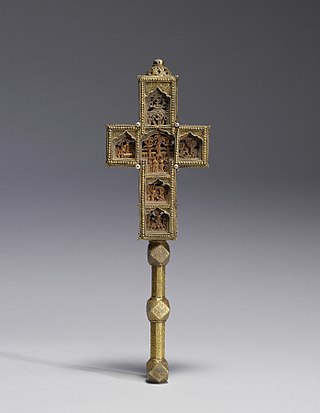
The Christianization of Iberia refers to the spread of Christianity in the early 4th century by the sermon of Saint Nino in an ancient Georgian kingdom of Kartli, known as Iberia in classical antiquity, which resulted in declaring it as a state religion by then-pagan King Mirian III of Iberia. Per Sozomen, this led the king's "large and warlike barbarian nation to confess Christ and renounce the religion of their fathers", as the polytheistic Georgians had long-established anthropomorphic idols, known as the "Gods of Kartli". The king would become the main sponsor, architect, initiator and an organizing power of all building processes. Per Socrates of Constantinople, the "Iberians first embraced the Christian faith" alongside the Abyssinians, but the exact date of an event is still debated. Georgian monarchs, alongside the Armenians, were among the first anywhere in the world to convert to a Christian faith. Prior to the escalation of Armeno-Georgian ecclesiastical rivalry and the christological controversies their Caucasian Christianity was extraordinarily inclusive, pluralistic and flexible that only saw the rigid ecclesiological hierarchies established much later, particularly as "national" churches crystallized from the 6th century. Despite the tremendous diversity of the region, the christianization process was a pan-regional and a cross-cultural phenomenon in the Caucasus, Eurasia's most energetic and cosmopolitan zones throughout the late antiquity, hard enough to place Georgians and Armenians unequivocally within any one major civilization. The Jews of Mtskheta, the royal capital of Kartli, that did play a significant role in the Christianization of the kingdom, would give a strong impetus to deepen the ties between the Georgian monarchy and the Holy Land leading to an increasing presence of Georgians in Palestine, as the activities of Peter the Iberian and other pilgrims confirm, including the oldest attested Georgian Bir el Qutt inscriptions found in the Judaean Desert alongside the pilgrim graffiti of Nazareth and Sinai.
References
- ↑ Geoffrey Wainwright. The Oxford History of Christian Worship. p. 152.
- ↑ Biwzand Eghiayean (1993). Heroes of Hayastan: A Dramatic Novel History of Armenia. p. 205.
- ↑ Diana Agabeg Apcar (2004). From the Book of One Thousand Tales. p. 62.
- ↑ "Armenian Church Of Eastern Diocese" . Retrieved 10 March 2023.